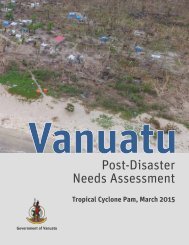Fiji
yqgk302EGjo
yqgk302EGjo
Create successful ePaper yourself
Turn your PDF publications into a flip-book with our unique Google optimized e-Paper software.
FIJI Post-Disaster Needs Assessment<br />
Mainstreaming disaster and climate risk within the national (and sub-national) development planning and budgetary<br />
system varies between sectors and levels of government, and needs to be consistent and enforced to ensure sustainable<br />
development, more resilient systems and safer communities to reduce future damage and loss from disasters.<br />
4.5.1 Identifying Increased Risks as a Result of TC Winston<br />
Following TC Winston, the damage incurred on some communities may have increased future risks from hazards. For<br />
example, where coastal defences were destroyed by storm surges, the risk from future storm surges, king tides and high<br />
tides to the community will have increased. Similarly, damage to vegetation on slopes has increased the future risk from<br />
landslides. As such, detailed surveys should be conducted to identify new risks in affected communities. Identification of<br />
new risks should be prioritized in areas where schools, health centres and critical infrastructure will be reconstructed.<br />
4.5.2 Promoting Risk Awareness at the Community Level<br />
Resilience at the community level is a critical component and outcome of an effective DRM system. Investment in<br />
community-based DRM (CBDRM) and climate change adaptation (CCA) activities can enhance community understanding<br />
of the risks to which the community is exposed and support the implementation of effective prevention, mitigation and<br />
preparedness activities. CBDRM initiatives are implemented by many agencies and government departments in <strong>Fiji</strong>. For<br />
example, Nawaqarua village in Ba Province constructed a community evacuation centre and conducted evacuation drills<br />
following participation in CBDRM training, which contributed to the fact that no lives were lost during TC Winston despite<br />
Ba being one of the most affected areas.<br />
Common methodologies for CBDRM and CCA initiatives with clear links to sub-national government processes should<br />
be encouraged. For instance, in the Western Division, CBDRM and CCA activities are already being integrated into the<br />
community and divisional development process, thereby ensuring that root causes of disaster risk are being addressed.<br />
This also provides an opportunity for investment in community infrastructure to be informed by an understanding of current<br />
and future risks to ensure resilience.<br />
4.6 Funding and Finance Mechanisms<br />
4.6.1 Building Fiscal Resilience<br />
While improving the resilience of the citizens of <strong>Fiji</strong> is paramount, the Government of <strong>Fiji</strong> should also aim to improve the<br />
country’s fiscal resilience to natural and climatic disasters. The first step to building fiscal resilience is to understand the<br />
country’s disaster risk profile as mentioned above. Once the hazard exposure is understood, actuarial analysis can be<br />
undertaken to provide indicative financial losses to these disasters.<br />
This analysis was undertaken for tropical cyclones and earthquakes/tsunamis in the PCRAFI, which noted that <strong>Fiji</strong> faced<br />
average annual losses of F$158 million (US$85 million) due to earthquakes and tropical cyclones. Furthermore, in the next<br />
50 years, <strong>Fiji</strong> has a 50 percent chance of experiencing a loss exceeding F$1.5 billion (US$806 million) and a 10 percent<br />
chance of a loss exceeding F$3 billion (US$1.6 billion). 132<br />
This PDNA provides an actual calculation of damage and losses which, when combined with past expenditures from<br />
disasters, help the government to better understand the contingent liabilities placed on the national budget from disasters.<br />
This will enable the government to develop an informed disaster risk finance and insurance strategy to build fiscal resilience<br />
against disasters.<br />
4.6.2 Disaster Risk Finance Tools in <strong>Fiji</strong><br />
<strong>Fiji</strong> has approximately F$3 million (US$1.6 million) available in contingent disaster risk finance and insurance (DRFI)<br />
instruments to facilitate disaster response. The National Disaster Relief and Rehabilitation Fund, also known as the Prime<br />
Minister’s Fund, can release up to F$1 million (US$0.5 million), and the recently established Rehabilitation Fund receives<br />
an annual appropriation of F$2 million (US$1 million). That said, in any given year, there is a 57 percent chance that <strong>Fiji</strong> will<br />
experience government emergency losses that exceed the F$3 million (US$1.6 million) contingency provision. 133<br />
132<br />
PCRAFI (Pacific Catastrophe Risk Assessment and Financing Initiative) (2011) Country Risk Profile: <strong>Fiji</strong>, September 2011.<br />
133<br />
PCRAFI (2014) Disaster Risk Finance and Insurance Note: <strong>Fiji</strong>, https://www.gfdrr.org/sites/gfdrr/files/publication/Country-Note-<strong>Fiji</strong>.pdf<br />
116 Tropical Cyclone Winston, February 20, 2016



